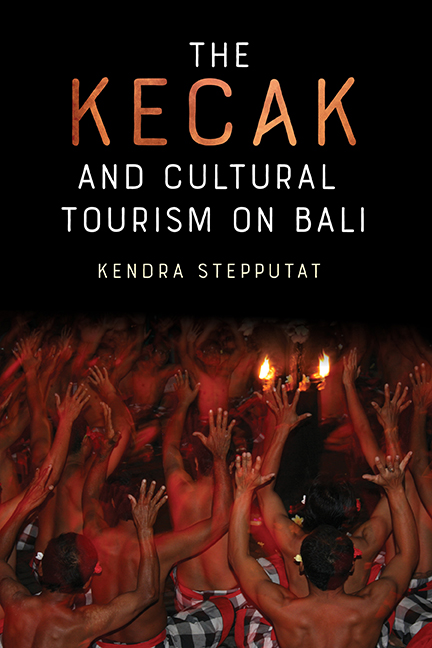Book contents
- Frontmatter
- Contents
- Acknowledgments
- Note to the Reader
- Introduction
- Part 1 The Present
- Part 2 The History
- Appendix 1 Kecak dan Wisata Budaya di Bali (Indonesian Summary)
- Appendix 2 Kecak Groups of Bali in 2000–2001 (Badung and Gianyar)
- Appendix 3 Facsimile of a Letter from Walter Spies to Leo Spies, 1932
- Glossary
- Bibliography
- Index
1 - Kecak: The Music
Published online by Cambridge University Press: 07 October 2022
- Frontmatter
- Contents
- Acknowledgments
- Note to the Reader
- Introduction
- Part 1 The Present
- Part 2 The History
- Appendix 1 Kecak dan Wisata Budaya di Bali (Indonesian Summary)
- Appendix 2 Kecak Groups of Bali in 2000–2001 (Badung and Gianyar)
- Appendix 3 Facsimile of a Letter from Walter Spies to Leo Spies, 1932
- Glossary
- Bibliography
- Index
Summary
The kecak, or cak, is based on noninstrumental, purely vocal sounds. Kecak itself is an onomatopoetic word derived from the sound of the “cak” calls voiced by the pengecaks. Speculations about the meaning of the syllable “cak” range from a reference to King Kicaka from the Mahabharata to the chirps of the common house gecko Hemidactylus frenatus, which is called cicak in Bali. However, Dibia states that “most likely the sound ‘cak’ has neither to do with heroes or lizards but is in fact a purely man-made sound with no meaning at all.”
When the word kecak (or the shorter form cak) is used, two meanings are inherent. The more common use of the word is to denote the genre also called the “monkey dance,” which is a dramatic dance performance with several solo dancers and a male vocal group that provides the musical accompaniment. Most authors use the term in this sense. However, there is a second meaning that may be attached to the term, namely the male vocal accompaniment group in sanghyang and kecak. Among Balinese experts, this use of the term is quite common. To differentiate between the genre and the group, the term tari (Indonesian for “dance”) is added to “kecak/cak” when referring to the genre. For the sake of consistency, I depart from this conversational use of the term and follow the more common convention of most academic and nonacademic publications: I use “kecak” or “cak” for the genre and “pengecaks,” “pengecak group,” or “cak group” for the male accompaniment in both sanghyang and kecak.
Kecak music is considered one of the great varieties of Balinese gamelan types, which also include genres termed “vocal gamelan,” or gamelan suara.
The cak group in kecak is comprised of 30 to 150 mostly male singers, who are called pengecak. They chant in unison, support the dancers’ movements with certain vocal noises, shouts, or rhythms, and provide the tight texture of interlocking cak calls that is the basis for the entire performance. Several solo singers known as juru (Balinese for “person with a special trade”) lead the rest of the cak group: the juru gending, the juru tembang, the juru klempung, the juru tarik, and the dalang.
- Type
- Chapter
- Information
- The Kecak and Cultural Tourism on Bali , pp. 13 - 43Publisher: Boydell & BrewerPrint publication year: 2021

